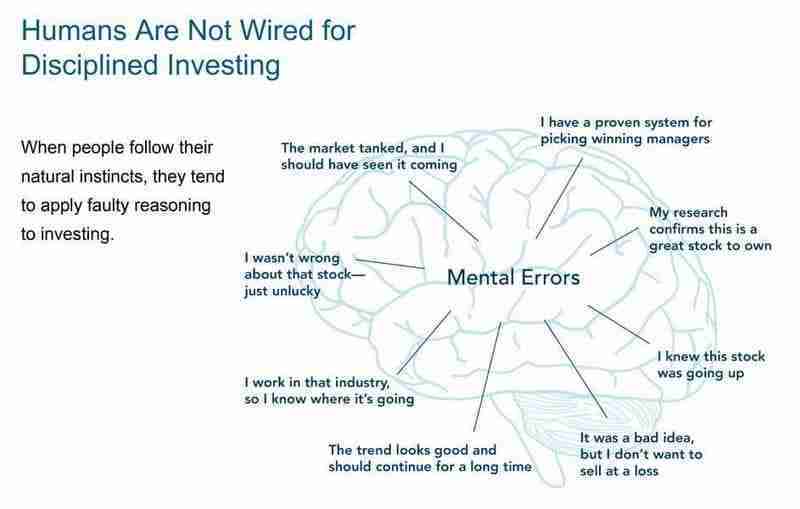Emotional Investing Is Risky Investing: Principle 8 in Evidence-Based Investing

Many people struggle with emotional investing. That is, they find it difficult to make consistent, rational investment decisions. Instead, they tend to react to current market conditions out of fear, excitement, or other gut instincts. Emotional investing leads to ill-timed trading and incurs unnecessary costs.
In “What Really Drives Higher Expected Returns?” we described how to employ stock and bond market factors within a disciplined investment strategy. That’s evidence-based investing. It involves extracting diamonds of promising sources of investment returns, or factors, from larger piles of misinformation.
We replace emotional investing with evidence-based investing by employing rugged, peer-reviewed and time-tested academic inquiry. But there’s one investment factor that can hinder an evidence-based investment strategy: the human factor, or your own impulsive reactions to market events.
Exploring the Human Factor

Despite everything we know about efficient capital markets and all the solid evidence available to guide our rational decisions … we’re still human. We’ve got things going on in our heads that have nothing to do with solid evidence and rational thought. Instead, we often engage in emotional investing by responding to a brew of chemically generated instincts and emotions that spur us to leap long before we have time to look.
Rapid reflexes often serve us well. Our prehistoric ancestors depended on snap decisions when responding to predator and prey. Today, our child’s cry still brings us running without pause to think; their laughter elicits an instant outpouring of love (and oxytocin).
In finance, where the coolest heads prevail, many of our basic instincts cause more harm than good. If you don’t know they’re happening or don’t manage them when they do, brain-triggered signals can trick you into believing you’re making entirely rational decisions when you are in fact being overpowered by “survival of the fittest” reactions.
Put another way by neurologist and financial advisor William J. Bernstein, MD, PhD:
“Human nature turns out to be a virtual Petrie dish of financially pathologic behavior.”
Behavioral Finance, Human Finance, and Emotional Investing

To study the relationships between our heads and our financial health, there is another field of evidence-based inquiry known as behavioral finance. What happens when we stir up that Petrie dish of financial pathogens?
Wall Street Journal columnist Jason Zweig’s “Your Money and Your Brain” provides a good guided tour of emotional investing, describing both the behaviors themselves as well as what is happening inside our heads to generate them. Two of the most obvious examples are as follows:
When markets tumble:
Your brain’s amygdala floods your bloodstream with corticosterone. Fear clutches at your stomach and every instinct points the needle to “Sell!”
When markets soar:
Your brain’s reflexive nucleus accumbens fires up within the nether regions of your frontal lobe. Greed grabs you by the collar, convincing you that you had best act soon if you want to seize the day. “Buy!”
An Advisor’s Greatest Role: Managing the Human Factor
Beyond such market-timing instincts that lead you astray, your brain cooks up plenty of other insidious biases that lead to emotional investing. To name a few, there are confirmation bias, hindsight bias, recency, overconfidence, loss aversion, sunken costs, and herd mentality.

Your Take-Home
Managing the human factor in investing is another way an evidence-based financial practitioner can add value. Zweig observes:
“Neuroeconomics shows that you will get the best results when you harness your emotions, not when you strangle them.”
By spotting when investors are falling prey to a behavioral bias that leads to emotional investing, we can hold up an evidence-based mirror for them, so they can see it too.
To see all 10 principles of Evidence-Based Investing at a glance, please visit our Evidence-Based Principles Guide. These principles inform our investing process.
About the Author Doug Finley
Douglas Finley, MS, CFP, AEP, CDFA founded Finley Wealth Advisors in February of 2006, as a Fiduciary Fee-Only Registered Investment Advisor, with the goal of creating a firm that eliminated the conflicts of interest inherent in the financial planner – advisor/client relationship. The firm specializes in wealth management for the middle-class millionaire.
Related Posts
Common Investing Mistakes (Part 3)
Common Investing Mistakes (Part 2)
Common Investing Mistakes (Part 1)
The Bumpy Road to the Market’s Long-Term Average
Playing the Prediction Game – Hindsight Is 20/20. Foresight Isn’t.
What’s Baked into Your Credit Exposure?
Top 500 Stocks, Give or Take $2.1 Trillion
Japan in the News, But It’s Nothing New
Session expired
Please log in again. The login page will open in a new tab. After logging in you can close it and return to this page.
